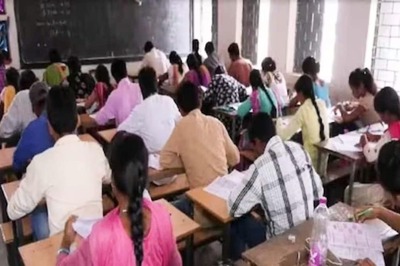
views
LES CAYES, Haiti:Lanette Nuel sits listlessly next to her daughter’s corpse outside the main hospital of Les Cayes in southwestern Haiti. The 26-year-old was crushed by rubble during the earthquake this weekend and died after there were not enough medics to attend her.
The hospital was even more overwhelmed on Tuesday than before as patients who were camping outside moved indoors overnight to escape Tropical Storm Grace, which swept through the same region hit by the magnitude 7.2 quake.
Flooding and heavy rains interrupted efforts to search for survivors and help those left homeless or without food and water by the quake, which killed at least 1,400 people and injured thousands.
But they resumed on Tuesday as aid agencies scrambled to scale up their response, although for some it was too late.
“There weren’t enough doctors and now she’s dead,” said Nuel of her daughter, herself a mother of two, now covered in a white sheet. “We came in yesterday afternoon, she died this morning. I can’t do anything.”
The quake on Saturday brought down tens of thousands of buildings in the poorest country in the Americas, which is still recovering from a temblor 11 years ago that killed over 200,000 people.
“Countless Haitian families who have lost everything due to the earthquake are now living literally with their feet in the water due to the flooding,” said Bruno Maes, the United Nations Childrens Fund (UNICEF) representative in Haiti.
“Right now, about half a million Haitian children have limited or no access to shelter, safe water, healthcare and nutrition.”
The United Nations said it had allocated $8 million in emergency funds to provide essential healthcare, clean water, emergency shelter and sanitation for all affected people.
“We will continue to scale up our response to the hardest-hit areas,” U.N. Secretary-General Antonio Guterres said in a statement.
At the hospital in Les Cayes, one of the worst-affected towns, about 150 km (90 miles) west of the capital Port-au-Prince, director Peterson Gede said medics were doing the best they could but it was not enough.
“We couldn’t handle all the patients,” he said. “And we have been receiving supplies but it’s not enough.”
At a tent city in Les Cayes containing many children and babies, over a hundred people scrambled to repair makeshift coverings made of wooden poles and tarps that were destroyed by Grace overnight. Some took cover under plastic sheets.
Mathieu Jameson, deputy head of the committee formed by the tent city residents, said hundreds of people there were in urgent need of food shelter and medical care.
“We don’t have a doctor. We don’t have food. Every morning more people are arriving. We have no bathroom, no place to sleep. We need food, we need more umbrellas,” said Jameson, adding the tent city was still waiting for government aid.
SMELL OF DECOMPOSING BODIES
Haiti’s latest natural disaster comes just over a month after the country was plunged into political turmoil by the assassination of President Jovenel Moise on July 7.
U.S. national security adviser Jake Sullivan said on Tuesday it was too early to gauge the impact of the quake on Haiti’s political process and that the United States, the country’s main donor, had no current plans to deploy U.S. military personnel to Haiti.
The U.S. Agency for International Development (USAID) said it had resumed rescue and relief operations on Tuesday morning after suspending them during the storm and was working with international partners to scale up assistance.
Several major hospitals were severely damaged, hampering humanitarian efforts, as were the focal points of many shattered communities, such as churches and schools.
Doctors worked in makeshift tents outside of hospitals to save the lives of hundreds of injured, including young children and the elderly. Haitian authorities said on Monday that 1,419 deaths had been confirmed, with some 6,900 people injured.
“This heavy rainfall should lead to flash and urban flooding, and possible mudslides,” it said.
Rescue workers have been digging alongside residents through the rubble in a bid to reach bodies, though few voice hope of finding anyone alive. A smell of dust and decomposing bodies permeates the air.
“We came from all over to help: from the north, from Port-au Prince, from everywhere,” said Maria Fleurant, a firefighter from northern Haiti.
With about 37,312 houses destroyed by the quake, according to Haitian authorities, and many of those still unexcavated, the death toll is expected to rise.
Prime Minister Ariel Henry, who was sworn in less then a month ago after Moise’s assassination, vowed to disburse humanitarian aid better than in the wake of the 2010 quake.
Though billions of dollars in aid money poured into Haiti after that quake and Hurricane Matthew in 2016, many Haitians say they saw scant benefits from the uncoordinated efforts: government bodies remained weak, amid persistent shortages of food and basic goods.
“The earthquake is a great misfortune that happens to us in the middle of the hurricane season,” Henry told reporters, adding that the government would not repeat “the same things” done in 2010.
Disclaimer: This post has been auto-published from an agency feed without any modifications to the text and has not been reviewed by an editor
Read all the Latest News, Breaking News and Assembly Elections Live Updates here.




















Comments
0 comment